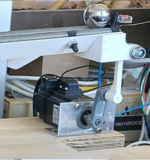matax
Newbie
I have a reisistor made out of 2 resistance wires and they get connected by a moving metal ball. The resistance changes from 6 Ohms to 66 Ohms. I need to make a circuit to read voltage(0V-10V) or current(4mA-20mA). Right now I read it with a voltage divider but its nonlinear and I'm looking for suggestions to make it linear what circuit should I use. All suggestions are appretiated and thank you for your time.
